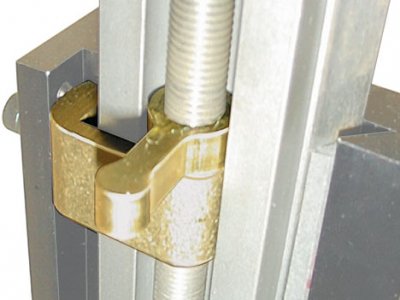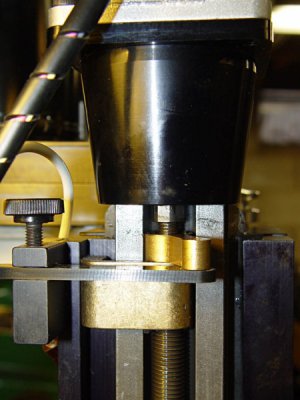- Joined
- Jul 28, 2017
- Messages
- 2,386
Yep, that's how it works. It tightens and loosens against the steel plate that is bolted to the table. If you take a look at your X2 you will immediately see that the plate is required for this to work. BTW the plate is 1/8" thick, seems plenty stiff for this application.Oh, so when you move the slotted piece back or forth, it turns the nut to take up the backlash. I see now, I think. Does it tighten or loosen against the carriage?
Sent from my VS987 using Tapatalk
I've found it is fairly easy to adjust. One small refinement I did after the initial install was to replace the philips head screw with an allen cap head -- it's much easier to loosen/tighten. To get a screwdriver on the philips head I had to run the table much further over to the right.
I've got DROs installed on my mill. With the AB mechanism adjusted reasonably tight, pushing/pulling on the table only produces .001" of motion according to the X axis DRO. The mechanical turns dial has to turn .002-.003" before the DRO reading changes by .001". Before the mod I was seeing .005" of table motion and the turns dial had to move .010" before the DRO readout would change by .001".
Aside from removing the table to drill/tap the mounting holes for the steel plate, the most involved part of this project was turning the lead screw nut down so it was perfectly circular. I made an expanding mandrel out of aluminum to fit the ID of the nut, installed it in my lathe (a micromark 7x12) and took it slow, since it was an interrupted cut in steel. I also cut the nut in half (with my parting tool) so I had an extra in case I screwed something up. That also reduced the extent-of-motion penalty imposed by the mod. Even with half the number of threads it's plenty beefy.
The other half of the nut can't be used to mod the Y axis because it uses left hand threads. If I just put a right-handed LS in there I still would have to buy a matching nut, since there must be TWO nuts per axis to implement the mod.
One potential issue is if you have a substantially worn lead screw. Since the two nuts are separated by several inches, it's possible that the outer nut could be in a less-worn portion of the LS, compared to the inside nut. The result would be a variable amount of backlash that depends on the table position. My mill is fairly new so I haven't noticed a problem but YMMV. It could be an excuse to get another lead screw





